Curiocity 2022 World Science Festival Brisbane (24 June – 10 July 2022) was hosted by Queensland Museum Network (QMN) and featured 16 temporary public artworks across Southbank, the Cultural Precinct, Queen St Mall, Goodwill Bridge, and Botanic Gardens.Artists: Georgie Pinn, Carol McGregor, Brian Robinson, Kellie O’Dempsey, Kirsten Baade, Erik Griswald/Rebecca Cunningham, Priscilla Bracks/Gavin Sade, Panos Couros, Helen Pynor, Michelle Vine/Perrin Ellis, Ephemera Lab (Jason Nelson/Alinta Krauth), QMF and Textile Audio, David Burrows & Australian Antarctic Program, Maria-Fernanda Cardoso, Donna Davis, Peter Thiedeke.
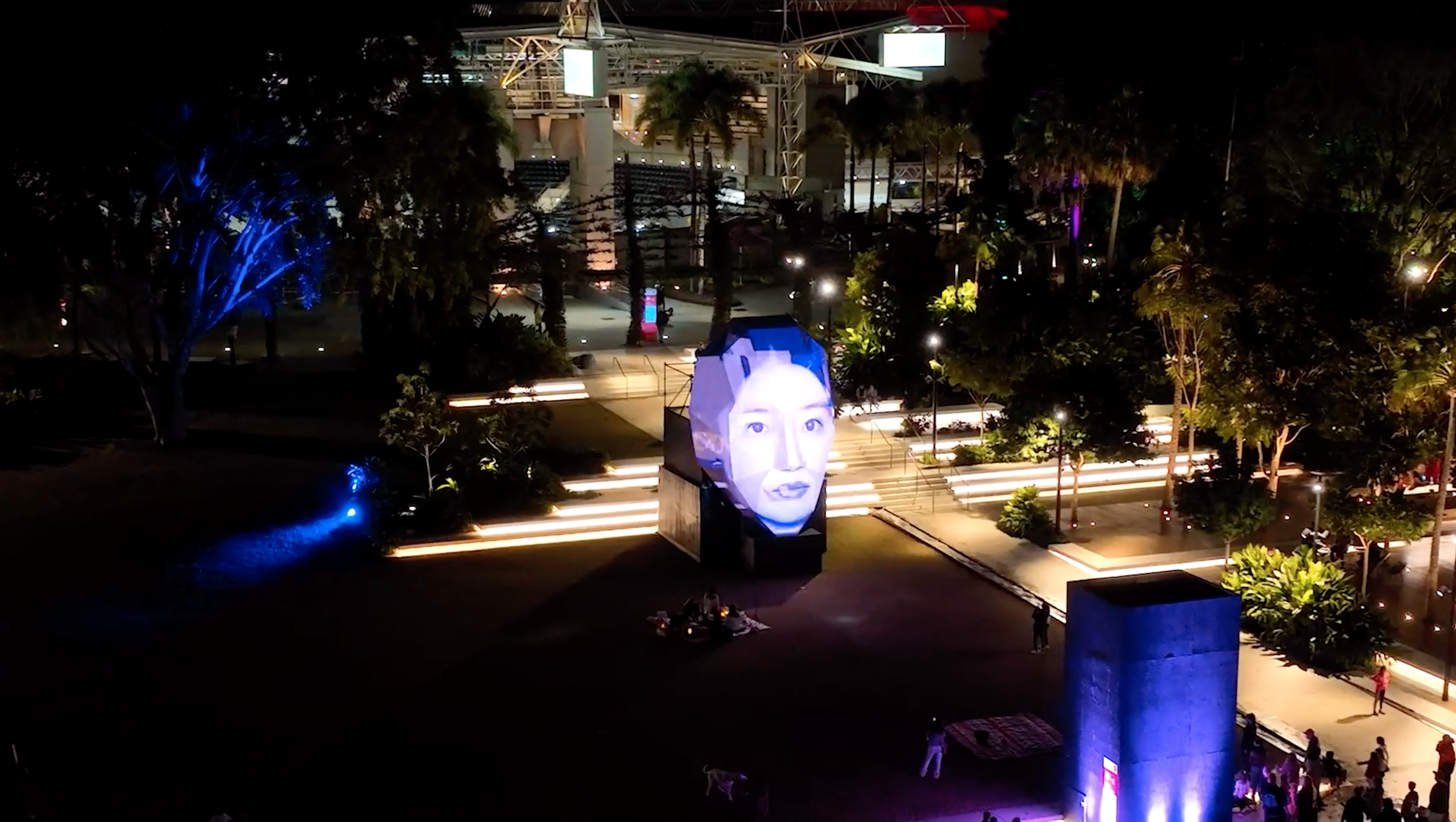
OCHE/ECHO
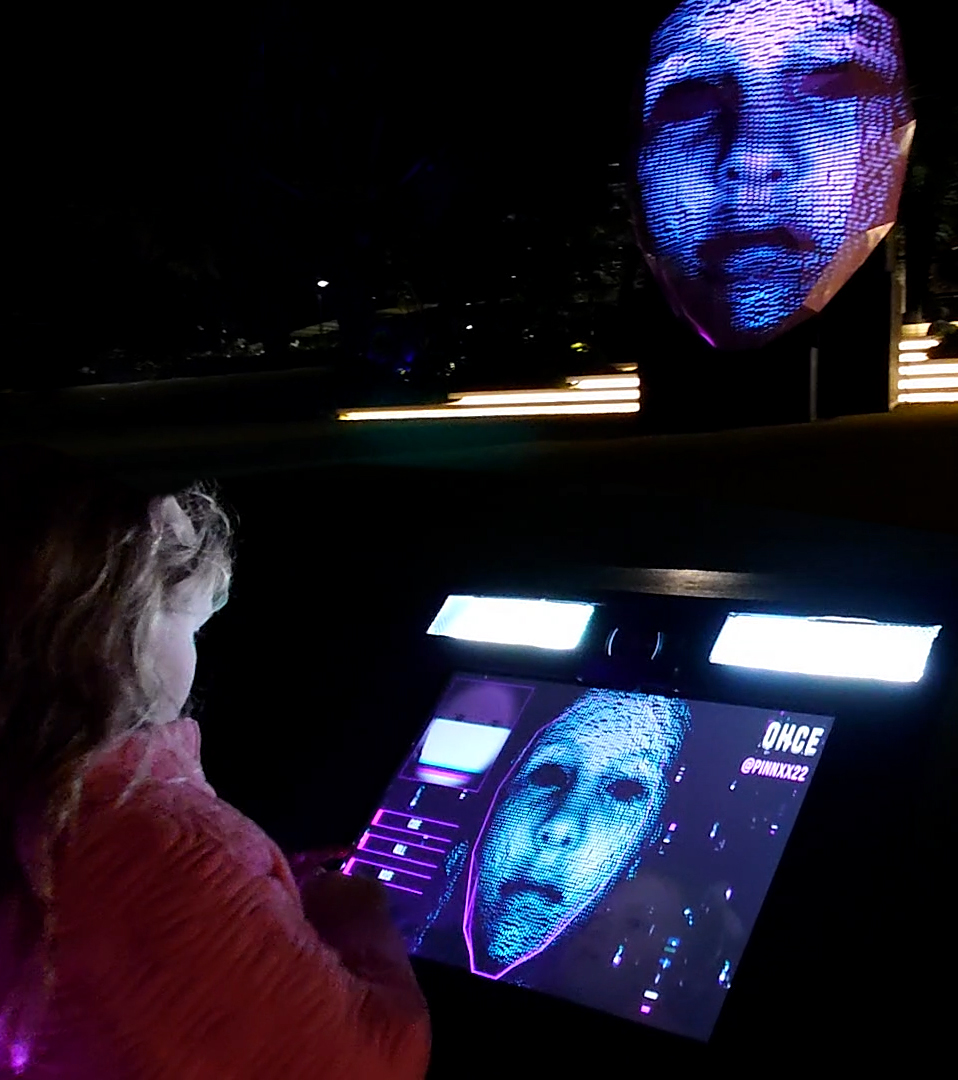
Georgie Pinn
Riverside Green, South Bank Parklands
Photo: Georgie Pinn
See Video of artwork here: Georgie Pinn
Multimedia artist Georgie Pinn’s interactive public sculpture, OHCE/ECHO used live generative animation, high-end facial capture technology and projection-mapped storytelling to look at empathy as well as prejudice and make us aware of our choices and perspectives.
The audience could literally imbed themselves into the artwork as their portraits were captured and manipulated creatively in real time into the continuously changing face projection. They then got to shapeshift by stepping into another’s story.
The giant storytelling device elevated the representation of the everyday person and challenged our own preconceived biases, posing the question of whether machines can teach us to be better humans.
The artwork ECHO was originally created in the gaming software Unity and then developed further into OHCE with over 40,000 portraits from its international tour. The generative software Touchdesigner was used to create an interactive and immersive console interface so that audiences can control the artwork directly.
During Curiocity Brisbane 2022, the artist was on site assisting the public to engage with the artwork 5pm-8pm.
Acknowledging Place
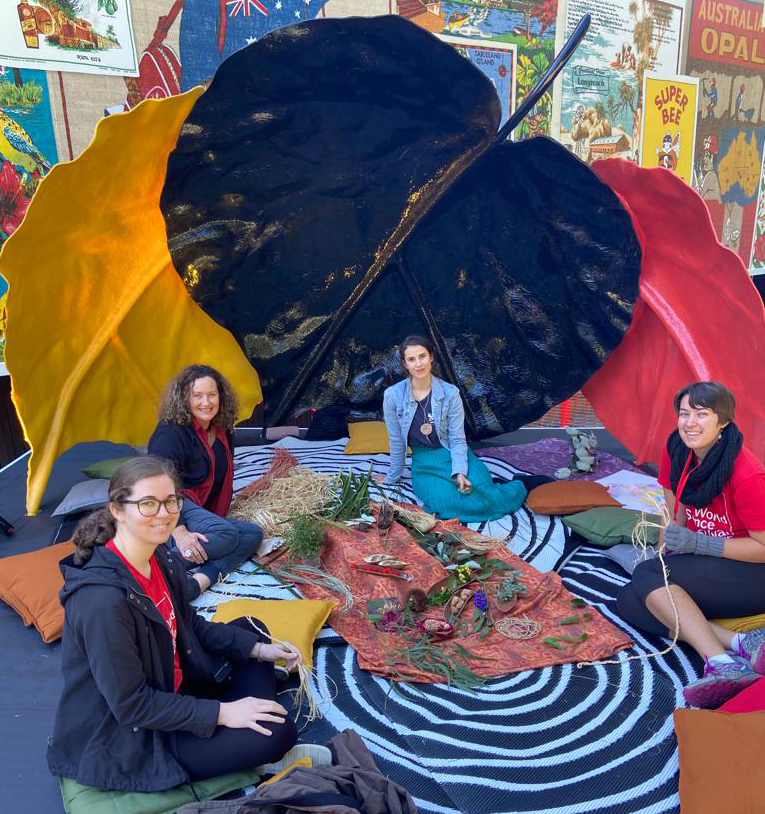
Carol McGregor
The Green, State Library of Queensland
Photo: Queensland Museum Network
Acknowledging Place is a space generated for physical reflection for you to sit under and consider an Aboriginal perspective of caring for Country.
The once prolific Cottonwood Tree or native hibiscus – Hibiscus tiliaceus was an important resource for Traditional Custodians of the Greater South-East Queensland region. Specifically, the inner bark of the tree provided fibre for making string for nets and dilly bags; the leaves and flowers were used for medicinal purposes and the young shoots and roots were eaten.
As an Aboriginal artist, acknowledging the Traditional Custodians and the Country I walk on is always present. Placing large versions of the Cotton Tree leaves in the colours of the Aboriginal flag in situ, aims to make the audience ponder what was here. To not only acknowledge the Traditional Custodians of the land they are walking on, but also think about their biocultural knowledges and in turn the effects colonisation had on our environment with introduced species and European land management practices.
During Curiocity Brisbane 2022 the work was activated as a gathering place for the sharing and recognising of an alternate knowledge system with yarning circles, storytelling and workshops.
Baidam Tithuyil
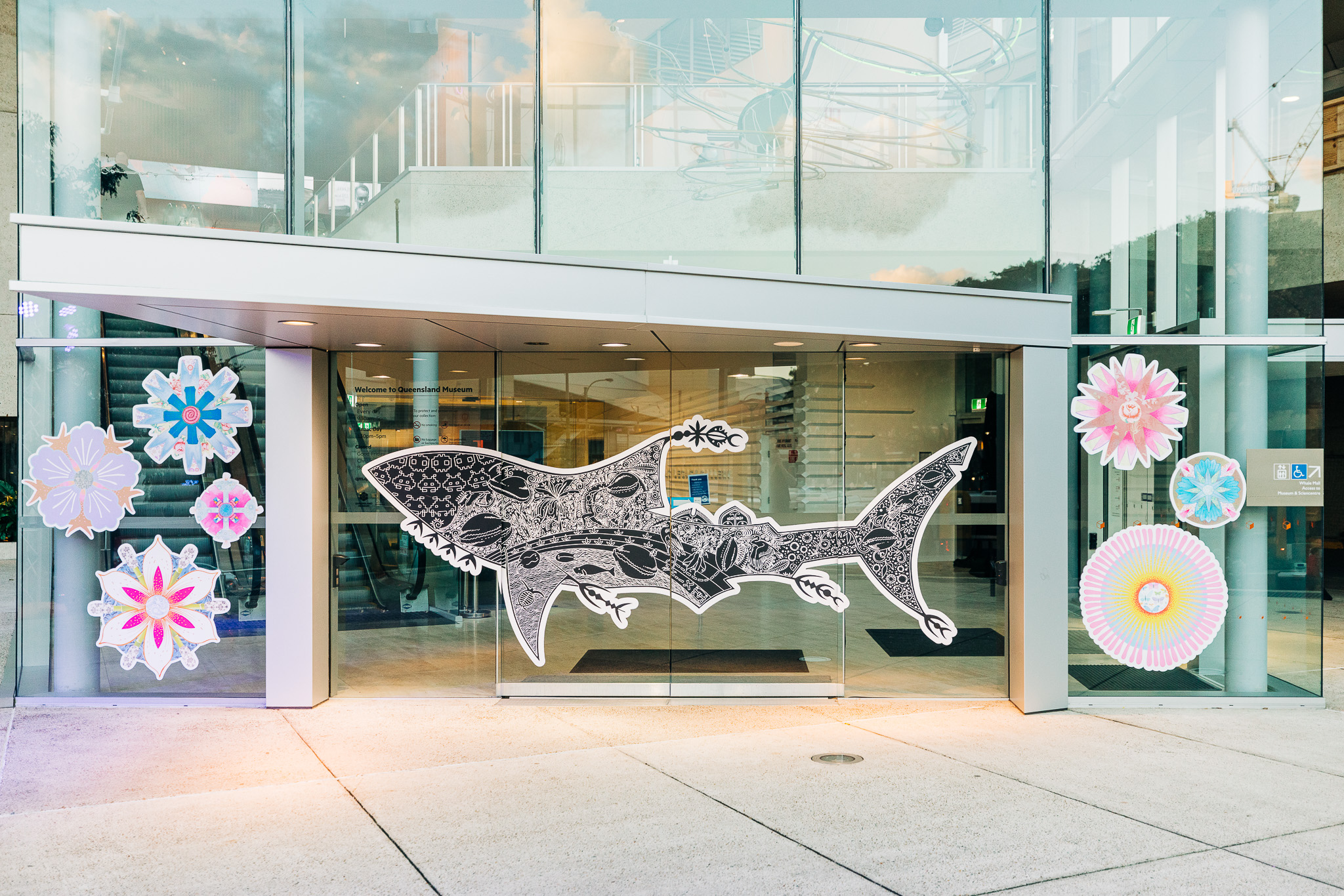
Brian Robinson
Queensland Museum Façade, Level 1 Entrance
Photo: Markus Ravik
Indigenous artist Brian Robinson explores the conceptual framework of traditional Torres Strait Islander astronomy with his large-scale artwork, Baidam Tithuyil that references the Great Shark constellation.
Everything under creation is represented in the sky. The stars inform Islander laws, customs and practices that are recorded and handed down in the form of story, song, dance, ceremony and artefacts. Astronomy plays a significant role in Zenadh Kes Torres Strait cultural traditions that link to constellations of stars in the southern sky. This includes Baidamu, the Great Shark constellation which is made up of the stars in the Big Dipper, part of the constellation Ursa Major (The Big Bear).
Baidamu first appears in the north over New Guinea during kuki (April). When these stars are seen, Islanders know the mating season of the shark is starting and that they should prepare their gardens with crops of banana, sugar cane, and sweet potato. Skill in gardening was dependant on understanding the seasons and the constellations including knowledge of tides, and the migration of animals.
In this artwork produced from a carved lino cut print, Robinson shares with audiences the importance of knowing and learning about these wonderous and unique aspects of Queensland cultural knowledge, so that they are respected as existing and enduring knowledges.
Soft-Body Adapters
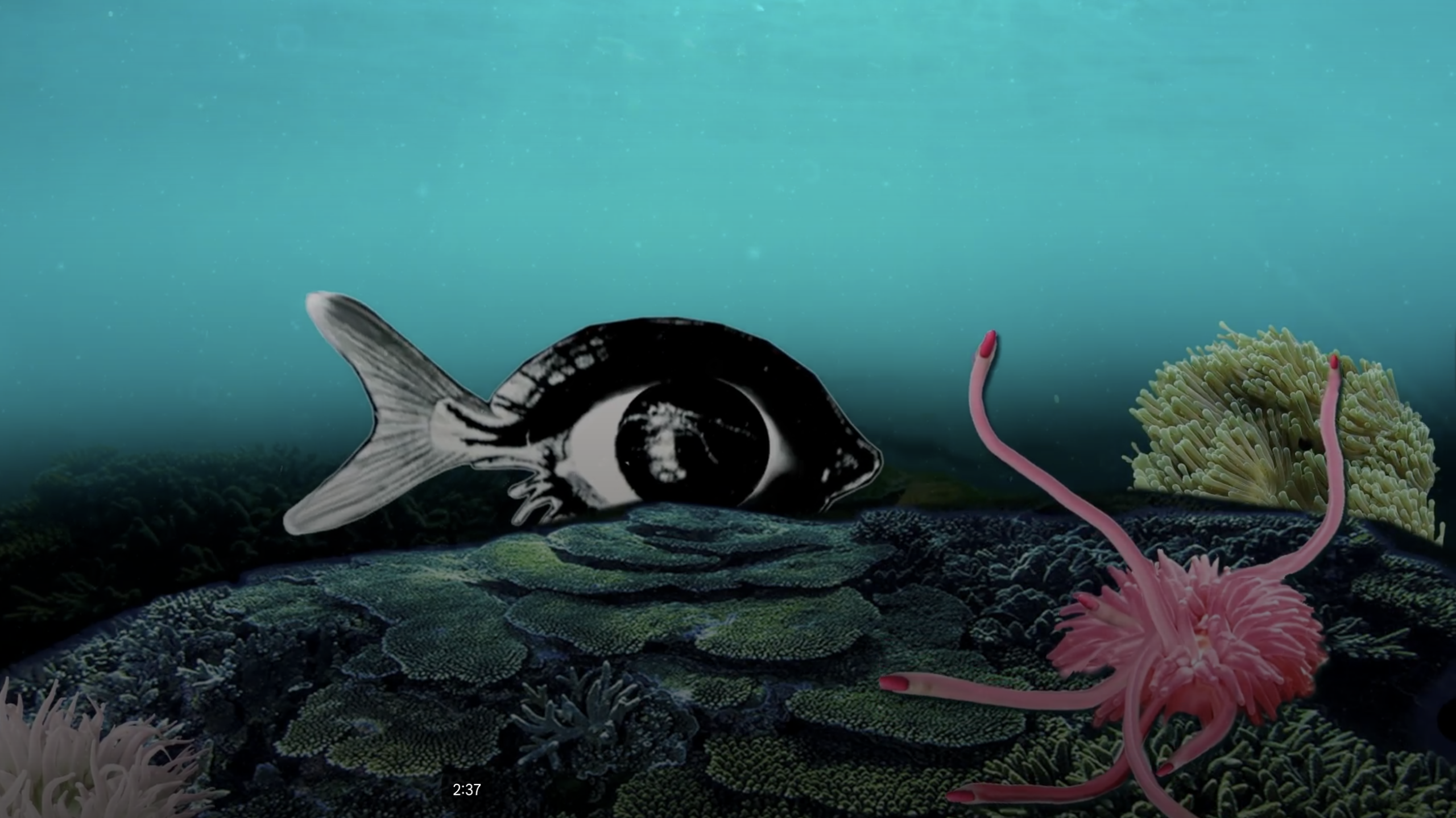
Kellie O’Dempsey
Knowledge Walk, State Library of Queensland
Photo: Kellie O’Dempsey
Drawing directly from the Queensland Museum Natural History Archive, Kellie O’Dempsey’s multi-dimensional artwork, Soft-body Adapters, takes a deep dive into the historic origins of ancient ocean biology to re-imagine the life of the ancient Anglerfish as marine and human hybrids.
Scientific evidence shows that the first vertebrates recorded in fossils were animals that looked like fish and had respiratory gills. This digital artwork reveals a psychedelic subaquatic ecosphere as a playful and absurd interpretation of what could happen to sea life as water encroaches onto the human landscape as the ocean levels rise.
Reconsidering our ancestors’ transition out of the water and onto the land through the lens of the climate crisis, Soft-body Adapters imagines a new biological adaption where ocean life metamorphosise from marine creature into human.
Made in collaboration mixing collage, animation and sound into digital video and augmented reality, Soft-body Adapters could be described as a Queensland underwater world crossed with surreal science fiction.
Roving demonstrators were on site during Curiocity to explain how to use the EyeJack app. and make social media posts with the images generated.
Artist Kellie O’Dempsey in collaboration with:
AR Animator: Helena Papageorgiou
Sound Artist: Mick Dick
Visual Artist: Jon Weber
Luminous Threads
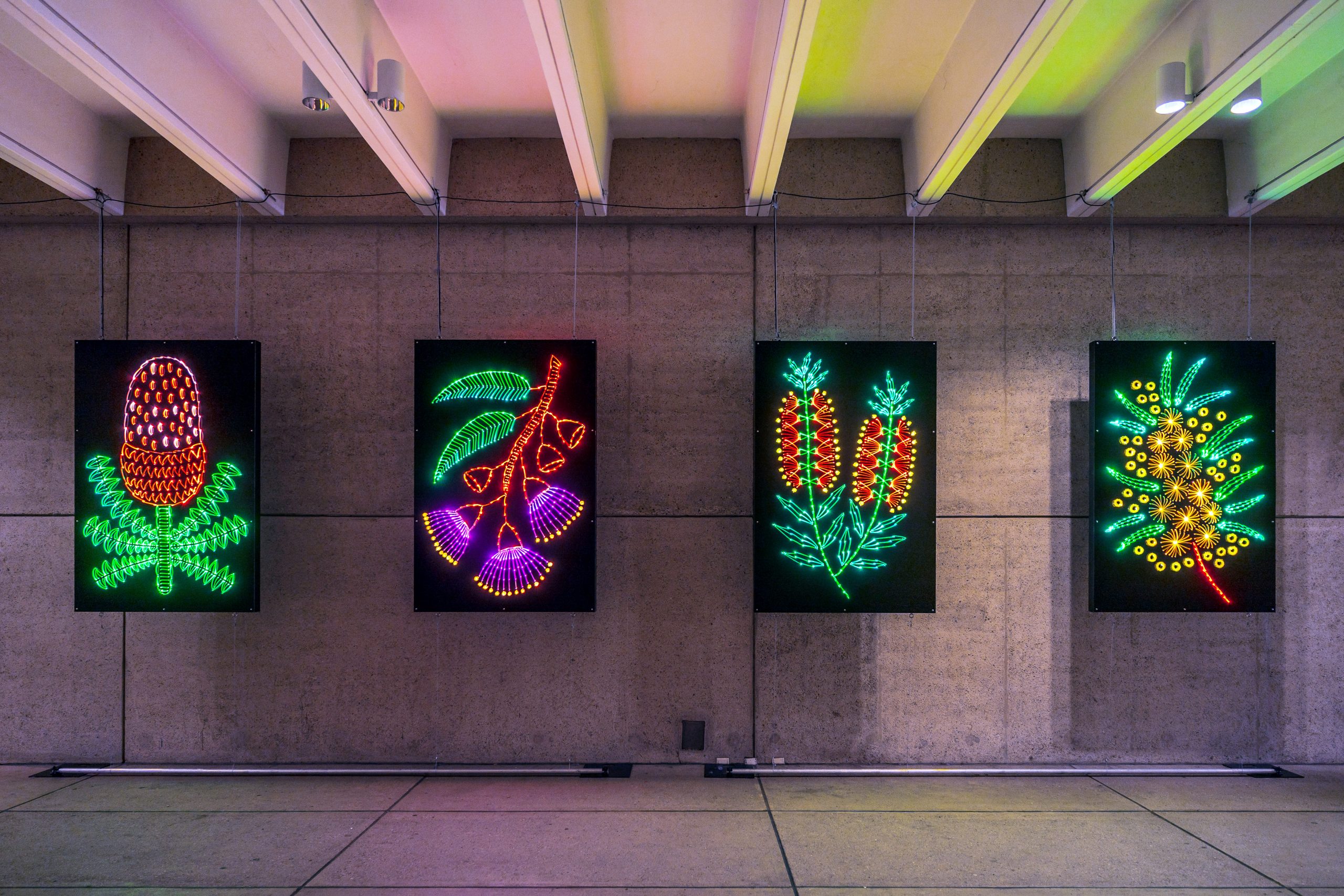
Kirsten Baade
Whale Mall, Queensland Museum
Photo: Dave Kan
Artist and engineer Kirsten Baade created a beautiful work of light art that combines the artisanal craft of embroidery with modern fibre optic technology.
Featuring colourful Australian floral motifs, Luminous Threads transfers the traditional homely craft into a large-scale public artwork to unite rather than separate technology and art.
Unlike traditional fibre optic cable that transports light form one end to the other, side-glow fibre optic cable emits light along the length of the cable, giving it the appearance of an illuminated thread. The resulting combination of light and electronics changes colour and intensity over time creating technological beauty and a sense of wonder.
Kirsten is interested in the viewer’s response to the artwork and if the work elicits a similar or different response to looking at a traditional piece of embroidery.
Sounding Tides
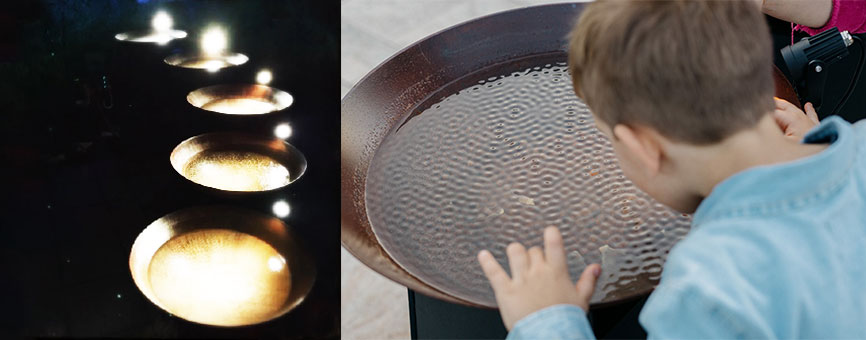
Erik Gridwold and Rebecca Cunningham
Clem Jones Activation Space, South Bank Parklands
Photo: Erik Griswold and Rebecca Cunningham (L) and Markus Ravik (R)
Composer and experimental musician Erik Griswold joined forces with climate change social scientist Rebecca Cunningham to create a kinetic sound sculpture that asks whether we can hear the climate changing.
Tides are some of the most constant phenomena in nature. The ebb and flow, the repetitive undulating rhythms, the constant tensions. Anthropogenic climate change rises tides around the world. Sounding Tides is an interactive musical composition and a sonification of scientific data that translates 40 years of data into sound and allows us to listen to these changes.
We hear the tides represented as slowly pulsing chords, shifting noise spectra, and dancing musical arpeggios, and we see the sound waves rippling and bubbling in water held within five large bowls.
The musician/scientist duo are interested in the ways ideas transform and new insights can be discovered when exploring data in a tactile and multi-sensory fashion. By sonifying the repeating cycles of the tides, hypnotic and meditative musical textures have been created using sine waves and white noise generators, accompanied by sampled piano. An interactive app enables participants to explore and mix the sonified data in their own way.
In The Air
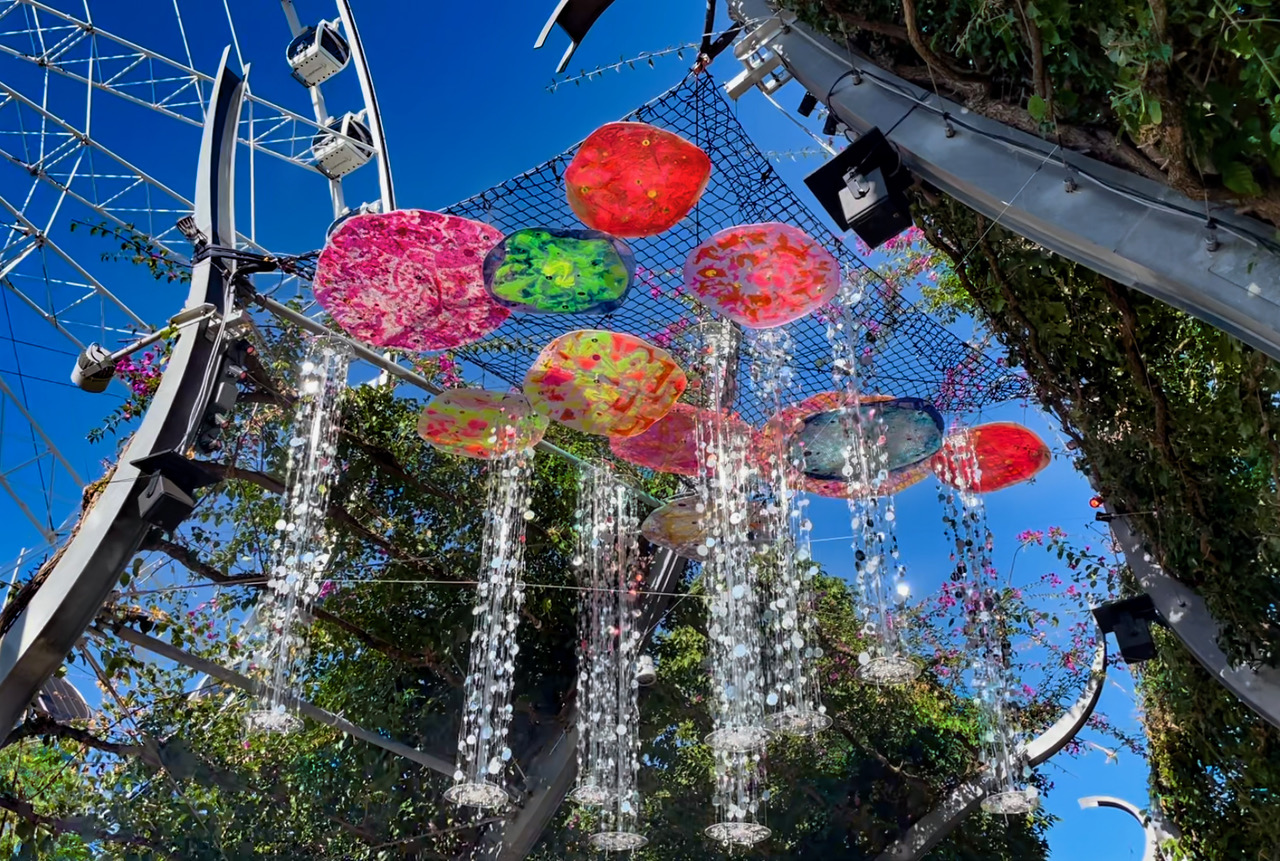
Priscilla Brack & Gavin Sade (Music: Greg Jenkins and Gavin Sade)
The Arbour, South Bank Parklands
Photo: Priscilla Bracks
In The Air is an immersive light and soundscape that uses data from Antarctic ice-core samples to visualise chemical changes in the Earth’s atmosphere. Hypnotic music and mesmerising light enveloped pedestrians in a poetic time-lapse that condenses changes over the past 400,000 years into half an hour. Visitors lingering in the space experienced the work’s rising energy as colour, movement and sound reflecting the exponential rate of change in recent centuries and the clarity of data confirming human impact on the Earth’s atmosphere and climate.
Long-time collaborators, Priscilla and Gavin are interested in the delicate balance between planetary interests and human concerns. Reclaimed plastic discs that float like gravity-defying bubbles above the installation, mimic this tenuously complex relationship as they rely on the sun’s movement to wash the space with colourful, shifting light.
By looking back in time audiences were invited to explore possible futures arising from present thought and action and consider new perspectives that situate humans within our broader planetary ecology.
AmphiSonic
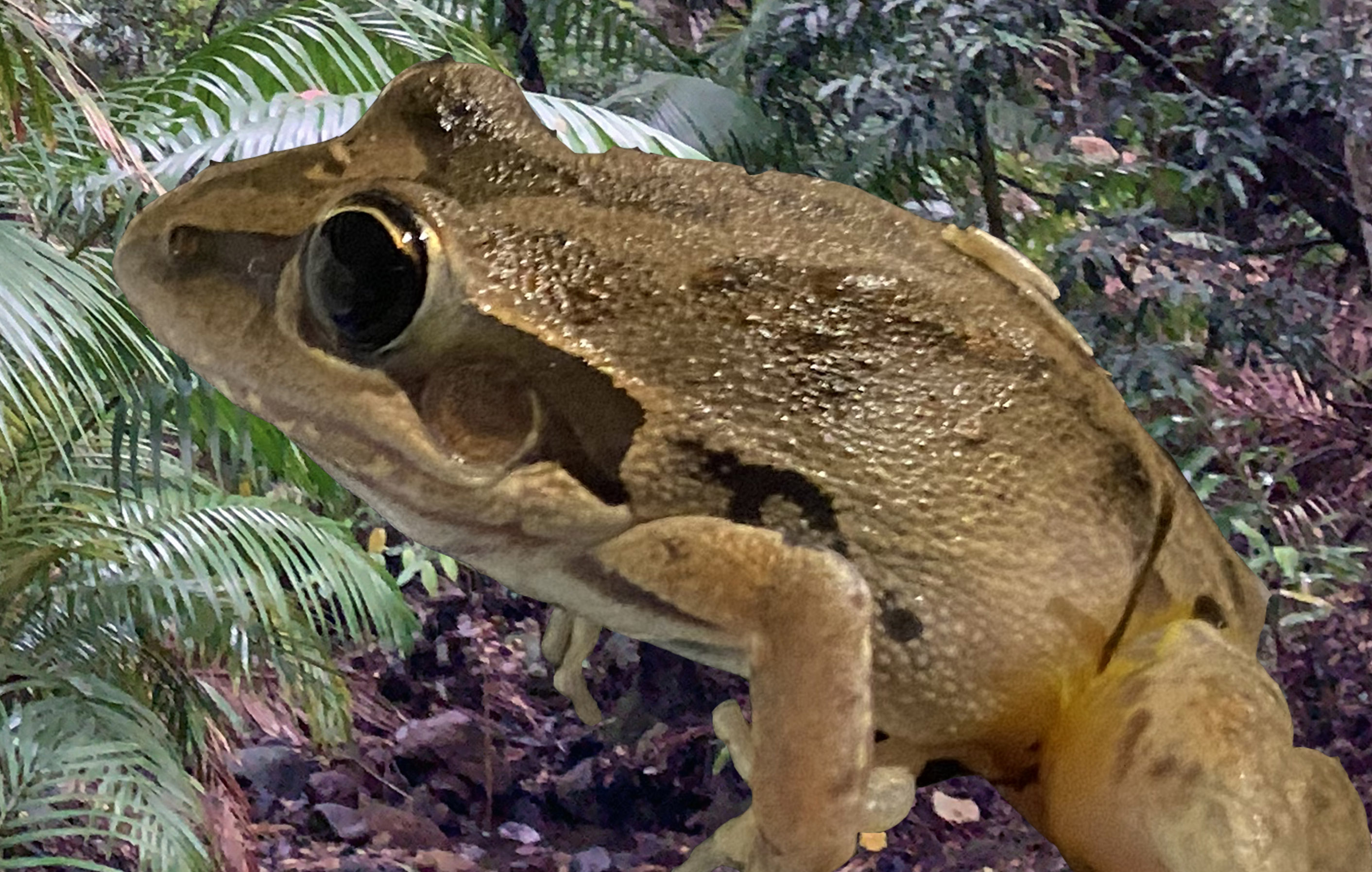
Panos Couros
Rainforest Walk, South Bank Parklands
Photo: Siyavash Doostkhah
Listen to Amphisonic Soundwork here
Principle Artist: Panos Couros
Poetry: Ali Coby Eckermann
Vocals: Ursula Yovich
Music:The Doon Doon Collective – Greta Kelly, Siyavash Doostkhah, Amanda King, Panos Couros
Leading Scientist: Assoc Prof Lee Berger, Principal Research Fellow (Wildlife Health & Co’N) Veterinary Biosciences, University of Melbourne
Associate Scientist: Danielle Wallace, Veterinary Biosciences, University of Melbourne
Voice Over: Jane Phegan
Electronic sound artist Panos Couros brings together the poetry and songs of First Nation artists, the knowledge of bio-scientists, the pulses and beats of electronic music, and the mating calls of frogs to create a large-scale immersive sound environment that challenges the audience to actively listen to the natural world around us.
The technology-based three-dimensional sound artwork highlights the essential role of frogs in the environment and as indicators of its health. It draws attention to the ancient wisdoms of First Nations people alongside the data-driven discoveries of contemporary scientific research dedicated to understanding the current mass extinction events that our frog populations are experiencing in Australia, and the subsequent loss of biodiversity this is causing.
Panos asks audiences to focus on the sensational wonder of the environmental world and listen to the music created by nature in the hope that by being present and attentive, we may reveal what is really happening around us and understand the life-giving story of our natural surroundings.
The artist was on site mixing sound throughout Curiocity
93% Human/Breathwork
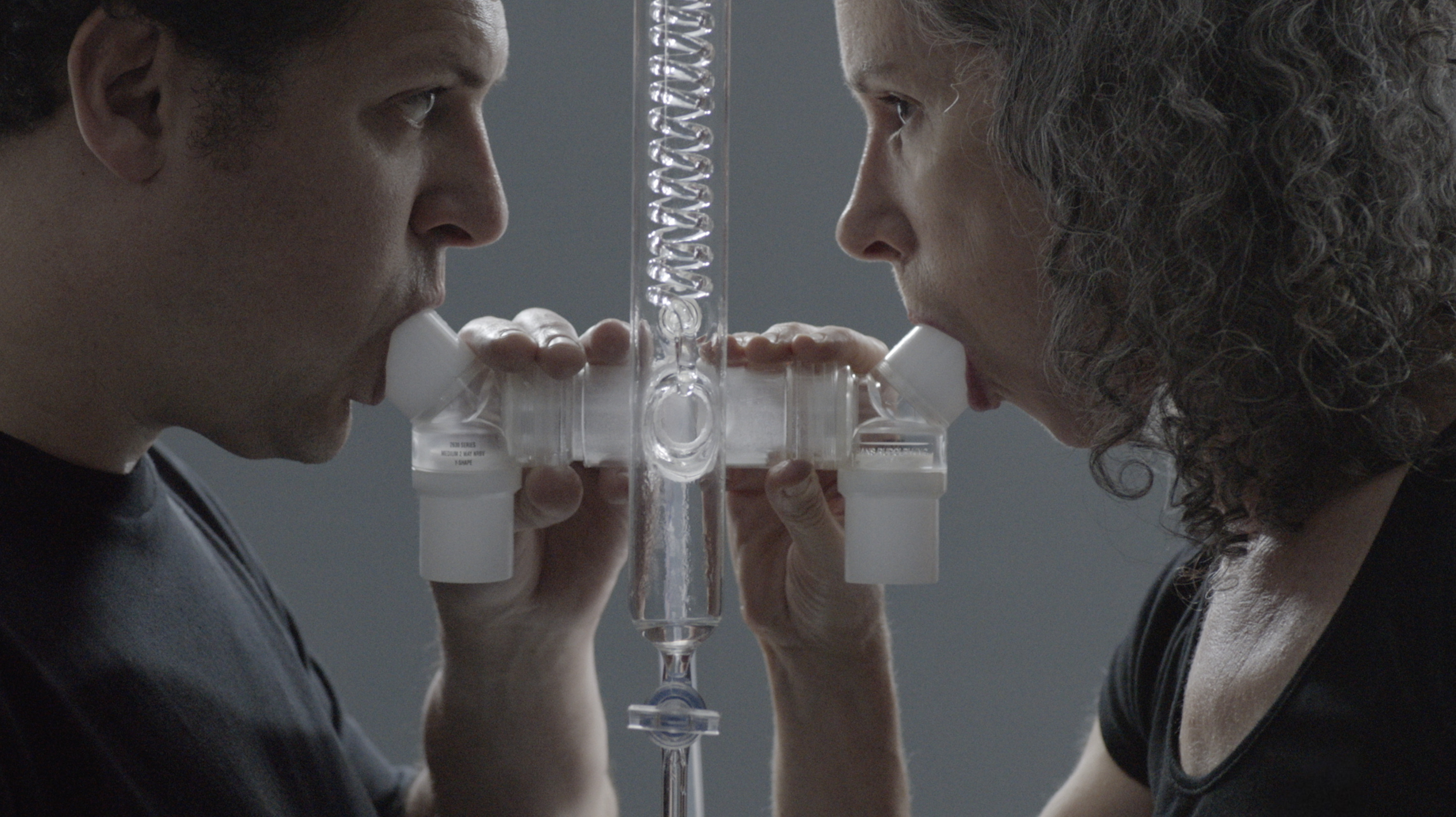
Helen Pynor
Level 1, AGL Foyer, Queensland Museum
Photo: Helen Pynor
Analysing DNA that is shed via the breath makes explicit the permeable nature of our bodies, and the unseen ways we are in constant exchange with human and non-human others.
Human DNA exhaled in our outbreaths, and inhaled by others in their inbreaths, is a little-known form of DNA shedding, although viral shedding from human outbreaths has become intensely scrutinised during the pandemic.
In the video 93% Human, Artist Helen Pynor and collaborator genomics scientist and bioinformatician Jimmy Breen use a scientific glassware condenser device, which converts gaseous breath into liquid, to capture a shared breath sample, from which their exhaled breath DNA is later extracted, sequenced and analysed.
This artwork has resulted from Pynor’s ANAT (Art Science Technology) – SAHMRI (South Australian Health and Medical Research Institute) Artist Residency.
The lightbox image, Breathwork is a metaphoric exploration of the body’s permeability, focusing on lungs as the site for the creation of breath and for material exchange between self and world.
The Wandering Birds Have Returned to the River
(Even Bernice)

Perrin Ellis and Michelle Vine
Rainforest Green, South Bank Parklands
Photos: Katie Bennett
What imaginary giant bird built these nests? What did they look like? And how did they act? Made of repurposed and reusable consumer goods and inspired by the giant megafauna of prehistoric Australia, these five thought provoking nests form an inviting, comfortable playground for visitors. The construction of the nests and the accompanying sound and AR elements hint at the nature of the nest makers.
This multi-layered installation draws from the paleontological record of pre-historic giant birds, and the rigorous speculation that goes into their reconstruction. It can be experienced in multiple ways: the physical nests, the mysterious narrative of the birds in AR, the ability to speculate about them via an online interface.
As contributors to this artwork, primary schoolchildren were asked to speculate on the possible structure and look of these ancient birds and their images have been used in the accompanying AR. Constructed using fabric, foam, pool noodles, recycled plastic, and LED lights, the artwork also takes advantage of contemporary technology, in the form of augmented reality (AR) as a means of adding a layer of imagination and interpretation.
CurioCreatures
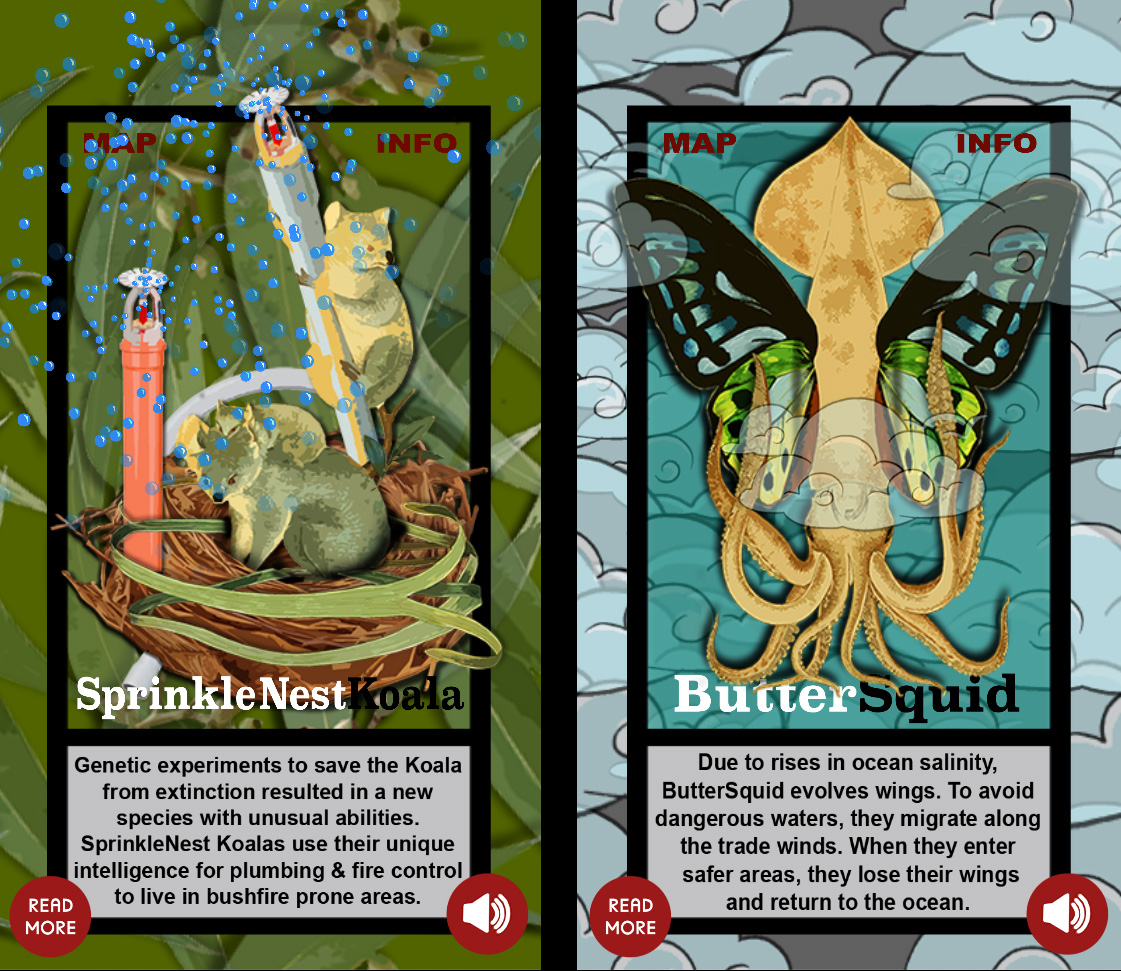
Alinta Krauth & Jason Nelson (EphemeraLab)
Cultural Precinct, South Bank Parklands, Goodwill Bridge, Queen St Mall
Images: Alinta Krauth & Jason Nelson
In the distant future, Brisbane looks very different, and its wildlife has adapted to a new climate and environmental reality. Through the lens of the observer’s phone, CurioCreatures reveals the fantastical and mysterious creatures who have survived and adapted to roam the streets of Brisbane and Australia.
These invented zoologically-changed creatures are dependent on humans allowing them to evolve and thrive in changed environments. This artwork asks audiences to remove themselves from the picture and think beyond the human world to the inherent importance of other species.
Interactive artists, designers and storytellers, Alinta Krauth and Jason Nelson draw from environmental themes, particularly with regards to species extinction, anti-speciesism, and climate change. They use playful and sometimes humorous digital strategies to guide people through physical spaces, to allow them to consider their surroundings differently.
Their ‘locative art’ uses interactive augmented reality so that end-users can use their own devices to engage with the artwork in their own time and on their own terms.
For more information: curiocreatures.com
City Symphony
QMF and Textile Audio
City Botanic Gardens, Goodwill Bridge, Queens Gardens, and Queens Street Mall
In City Symphony, QMF and award-winning composer, mezzo-soprano, and sound artist Eve Klein (Textile Audio) invited people to immerse themselves in bespoke locations and ‘hear’ Brisbane City through music and local stories.
Exploring hidden worlds of sound-in-space that reveal themselves differently to each user, City Symphony responds to each user’s location, orientation and even the time of day, to create a personal soundtrack that inspires exploration and interaction with place.
The digital artwork is made using video game creation techniques and technologies. It takes real-time information from a person’s phone and combines it with environmental data to generate unique music and story experiences for each listener. It combines AR-based game music creation with community placemaking. The creators worked with hundreds of community members and artists to craft an experience about the place and people of Brisbane.
QMF hosted free guided tours of City Symphony during Curiocity Brisbane 2022.
MIRAGE PROJECT (ICEBERG)
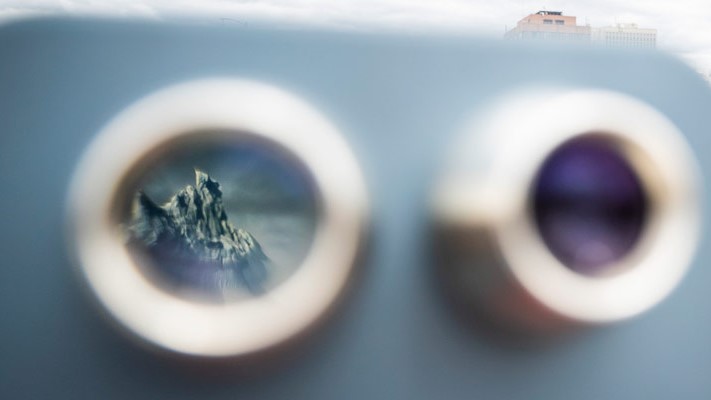
David Burrows & Australian Antarctic Program
Streets Beach, South Bank Parklands
Photo: David Burrows
MIRAGE PROJECT [iceberg] is a stereoscopic photography installation that aims to inlay an iceberg from Antarctica into South Bank. Breaking free from the confines of the gallery, artist David Burrows opens the spatial relationship to larger issues of landscape, environment, and architecture.
Viewers are positioned in the same spatial layout as the positions of the original photos. By walking from viewer to viewer you are in fact walking around an iceberg. The 3D photo in each viewer becomes a window onto a parallel world, interweaving this glorious ice monument into the fabric of the city.
The idea is to convey the extraordinary experience, sense of wonder and discovery inspired by getting up close to an iceberg. The Antarctic reality contrasts against the urban environment.
This artwork was made possible with the support of the Australian Antarctic Program (AAP). Since 1984 the AAP has taken creatives south to experience Antarctica, the sub-Antarctic and the Southern Ocean and Australia’s activities there, so that they can communicate these unique first-hand experiences, insights and understanding to others.
The Origins of Art I and II
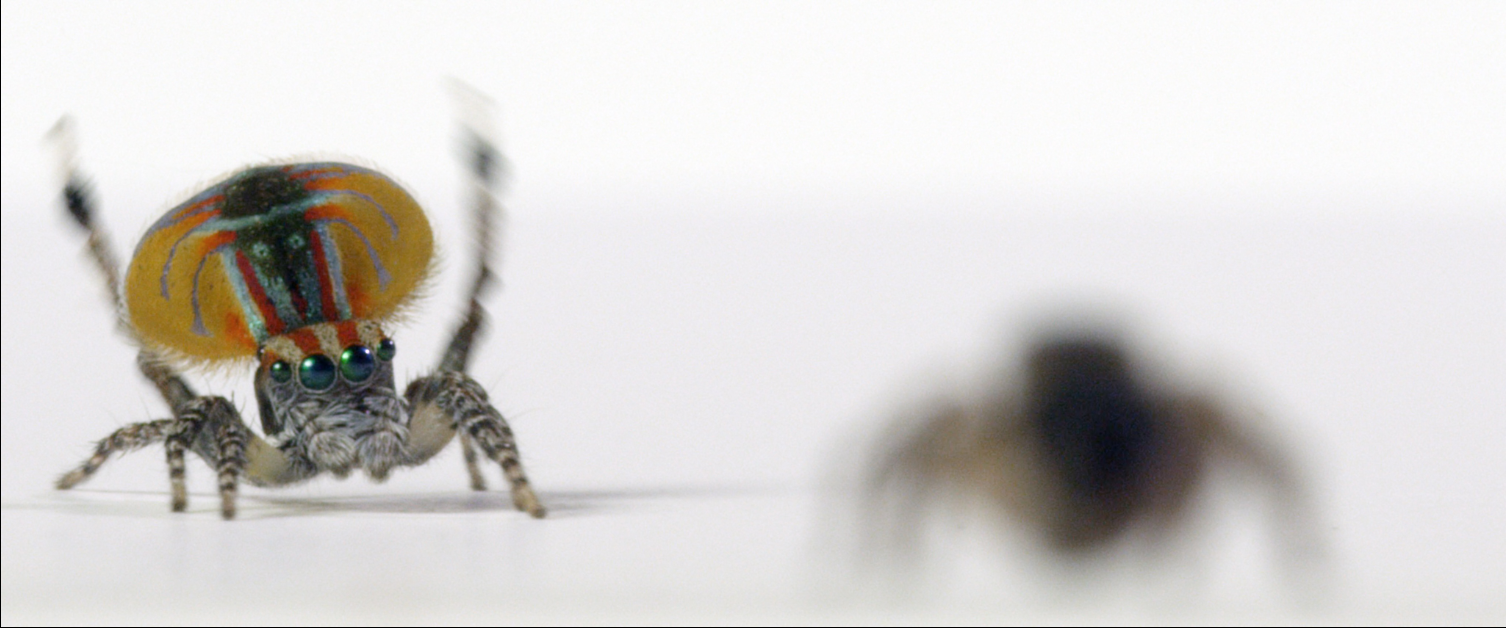
Maria-Fernanda Cardosa
Video Screen Queensland Conservatorium Outdoor Stage
Image: Maria-Fernanda Cardosa
María-Fernanda Cardoso explores the art forms of the animal world through the mating rituals of a tiny eight eyed Australian peacock spider or Maratus.
Like peacocks and birds of paradise, the male Maratus has developed a complex system of courtship display that exhibits its prowess as a dancer, musician and visual artist. Cardoso has recorded their ostentatious mating ritual using HD macro cinematography and a laser vibrometer, capturing their conspicuously colourful dance and the distinctive beat they make with their vibrating abdomens.
In presenting an art form of performance and display that is not created by, or for, humans, Cardoso argues that humans are not alone in their production and appreciation of the arts. The performing spiders that make these artworks are the product of an evolutionary process of sexual selection that has refined and enhanced their sensory apparatus, creating a discerning aesthetic sense controlled by the females, in which each performance’s aim is to perpetuate life over to the next generation.
DE-CAY-dence
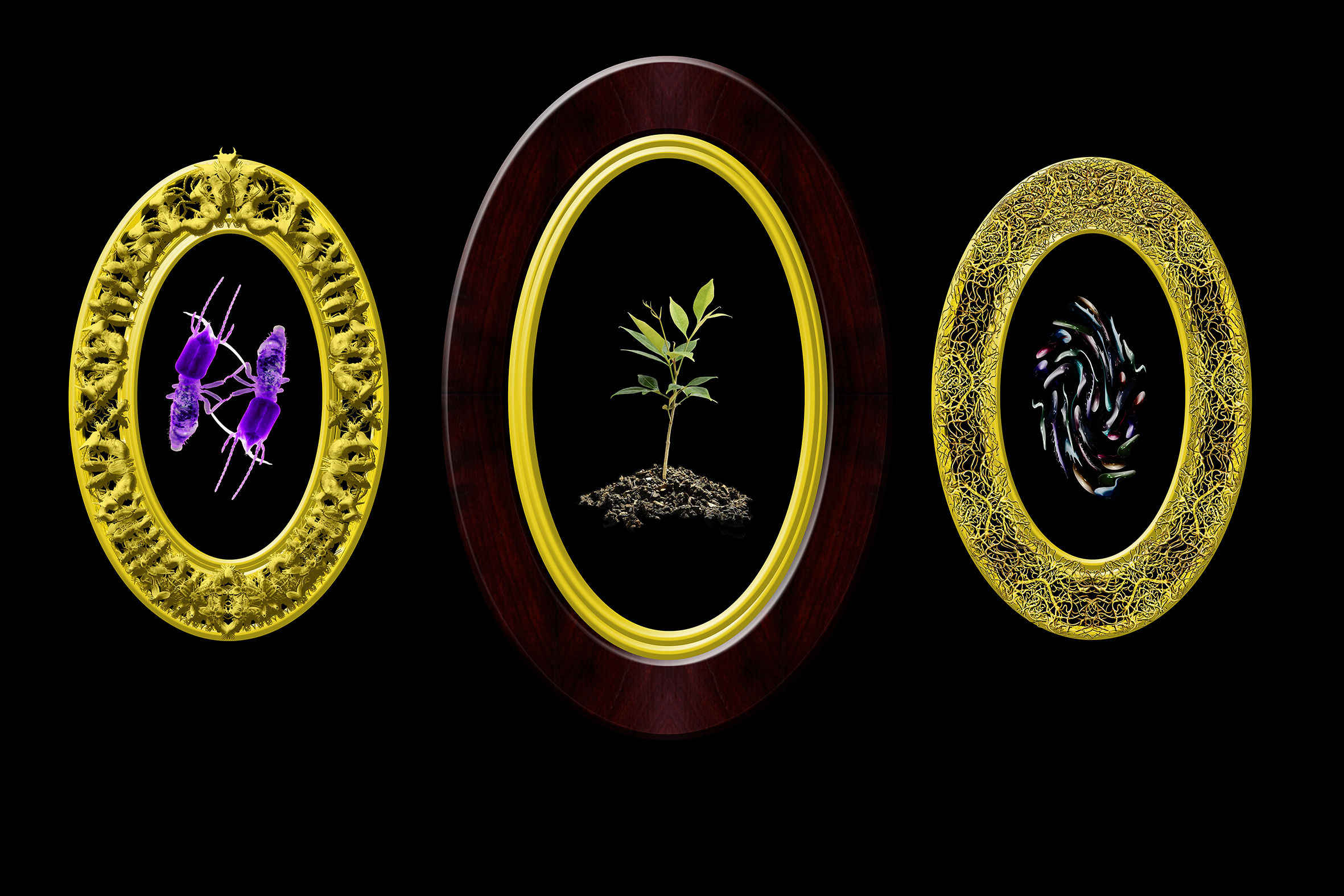
Donna Davis
Video Screen Queensland Conservatorium Outdoor Stage
Image: Donna Davis
Humans are intrinsically linked with the planet and therefore share the same fate; the health of both depends on us to nurture a new ecological paradigm.
DE-CAY-dence asks how and why we assign value to other organisms and how this informs our ecological action.
Playing with the idea of ‘Who IS the fairest’ the work challenges our unconscious bias with respect to terms such as pest, germ, decay, versus notions of beauty, value and status, to explore how these beliefs inform our ecological understanding and action.
Donna worked with Entomologists, Mycologists, Ecologists, Microbial Ecologists and Mathematicians to create this video animation, which uses a combination of sculpture [microbes + fungi], photography [flora + timber], stop-frame animation [animation sequences], stereomicroscopy [source images of termites courtesy R. Clement, GWU] and digital design [frames, termites, microbes + fungi].
This artwork was created in response to an art-science residency embedded within a current environmental research project: The Wood, Termite & Fungi Project; an international project led by University of Miami, studying tropical deadwood carbon fluxes, in order to improve current carbon models used for climate forecast modeling.
This project has been assisted by the Australian Government through the Australia Council, its arts funding and advisory body. Special thanks to Rebecca Clement, George Washington University and Stuart Worboys, Australian Tropical Herbarium for supplying some of the source images for the artist to digitally alter and reimagine for the artwork.
Communing with robots
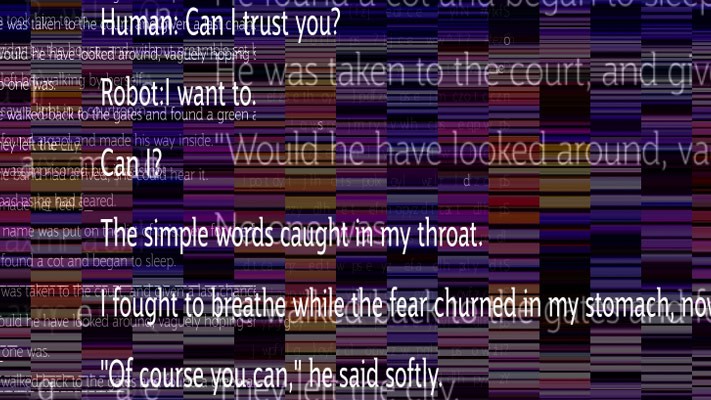
Peter Thiedeke
Video Screen Queensland Conservatorium Outdoor Stage
Image: Peter Thiedeke
Communing with robots asks: what will human agency mean when centralised artificial intelligence mediates our experience of public and private life? Will anonymity, privacy and trust be possible in a world where AI ‘knows’ you better than you know yourself?
In making this video the artist asked a robot the same question three times: can I trust you? Each time the robot responded differently.
The robot, a GPT-2 algorithm, is an open-source artificial intelligence that scrapes and remixes data from a myriad of web sources to generate responses. The kinetic text included is robotic fiction with a degree of coherence, however, without any fixed structure the AI produces an inconsistent and unpredictable—albeit fascinating—stream of consciousness. The diverse and often bizarre references to fictional characters and situations are strangely beautiful. With childlike innocence, poetry emerges from GPT-2’s non-human choice of words.

